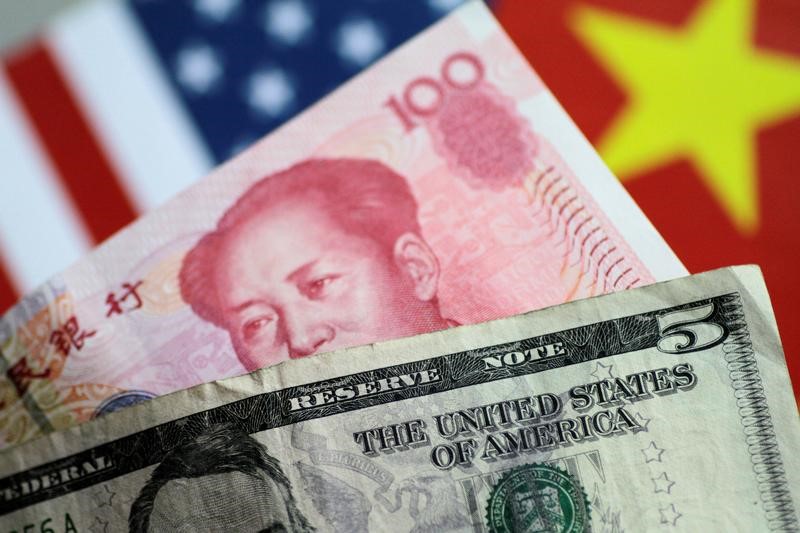(This version of the story corrects the date of remarks by Fed's Kaplan to July 14 in paragraph 14)
By Marius Zaharia
HONG KONG (Reuters) - In September 2015, the U.S. Federal Reserve cited risks from China as a key reason for delaying its first interest rate hike in a decade. A wall of Chinese debt maturing in the next few years could jolt the country back into the U.S. central bank's policy deliberations.
Two years ago, it was a collapse in Chinese stocks, a surprise yuan devaluation and shrinking foreign exchange reserves that roiled financial markets that delayed the Fed, but it did raise rates three months later and has tightened further since.
Now, some see risks emerging in China's dollar-denominated bonds that could give the Fed greater pause for thought as it raises rates, even as other central banks signal a shift from ultra-easy policy.
To be sure, Fed officials have not publicly flagged China's debt as a major risk in their policy discussions. However, debt analysts point to the possibility of another September 2015 moment in which the Fed takes its cues from concerns about China.
"Back then, I said that U.S. monetary policy is not made in Washington, it's made in Beijing," said Joachim Fels, global economic advisor at bond giant PIMCO.
"China does have a major impact on monetary policies elsewhere ... This year has been smooth sailing for global central banks because there were no shockwaves from China but I expect that to change if we think beyond the next few months."
The outstanding amount of dollar bonds issued by Chinese entities has grown almost 20 times since the 2008-09 global financial crisis to just over half a trillion dollars, according to data from the Bank for International Settlements. Since September 2015, it has grown almost 50 percent.
China's dollar bonds are now almost a third of the emerging market total dollar issuance, up from a quarter in September 2015 and less than 5 percent before the Fed first began printing money in December 2008.
A fifth of China's dollar bonds mature within a year, according to BIS data. More than half are due in the next five, Thomson Reuters data show.
If U.S. borrowing costs start rising as a result of the Fed's exit from its unconventional monetary policy, that debt would have to be rolled over at higher costs, chipping away at the real economy in China.
Alternatively, Chinese companies might decide to refinance their debt in local currency, creating weakening pressure on the yuan.
Either development would reverberate globally and create a major external challenge for Fed policy.
FEEDBACK LOOP
For its part, the Fed doesn't see any immediate dangers with China's dollar debt.
"You'll find if you look at China they certainly have dollar-denominated debt but ... you'll see that they are not as reliant on external debt as people might have thought," Dallas Fed chief Robert Kaplan said in Mexico City on July 14.
Also, a significant portion of Chinese dollar borrowing makes economic sense -- such as companies funding overseas investment projects. And if those dollars are converted into yuan, they could help ease any weakening pressure on the Chinese currency.
For now, dollar borrowing conditions remain stable with 10-year benchmark U.S. yields (US10YT=RR) still low by historical standards, despite four Fed rate hikes since September 2015. Broadly, the dollar (DXY) is as strong now as it was back then.
Indeed, the bigger risk focus for many analysts currently is not China's dollar bonds, but its local currency debt, which ratings agencies estimate to be almost three times the size of the economy.
But analysts say that the longer China's rapid accumulation of dollar debt continues, the harsher the future adjustment for the economy will be, especially if lenders start repricing Chinese credit risk.
"Regardless of how you cut your pie, you'll discover debt is a big problem. China has made a major contribution to global leverage since 2008," said Aidan Yao, senior emerging Asia economist at Axa Investment Managers.
"When markets start to wobble, there's a feedback loop that has an impact on the Fed's trajectory. Policy normalisation is not going to be in a straight line."
A forced deleveraging could renew weakening pressure on the yuan as dollars find their way out of the country, although capital controls help mitigate that risk.
"While the market generally believes that money flows have stabilized and the worst of the yuan's slide is over, the reality may well be the opposite," said Kevin Lai, chief economist for Asia ex-Japan at Daiwa Capital Markets.
"As more dollar debt has been taken up, the pressure on outflows is merely being delayed. Such pressure is also getting bigger, not smaller. This would eventually feed into even bigger downward pressure for the yuan."
For a graphic on 'Outstanding dollar bonds in China' click http://fingfx.thomsonreuters.com/gfx/rngs/CHINA-DEBT/0100421K4FL/CHINA-DEBT.jpg
